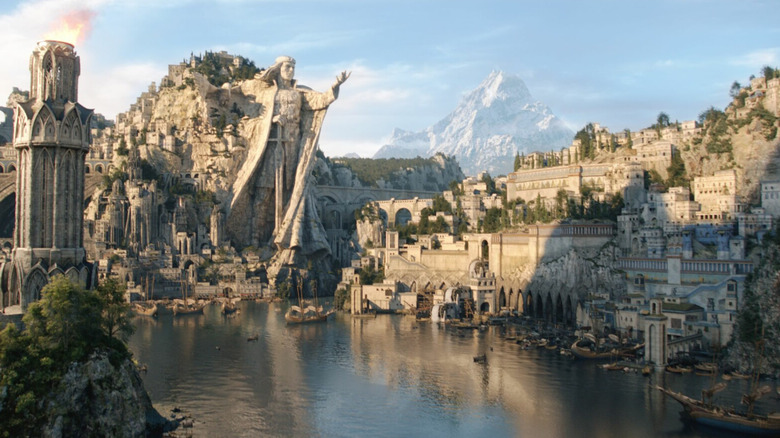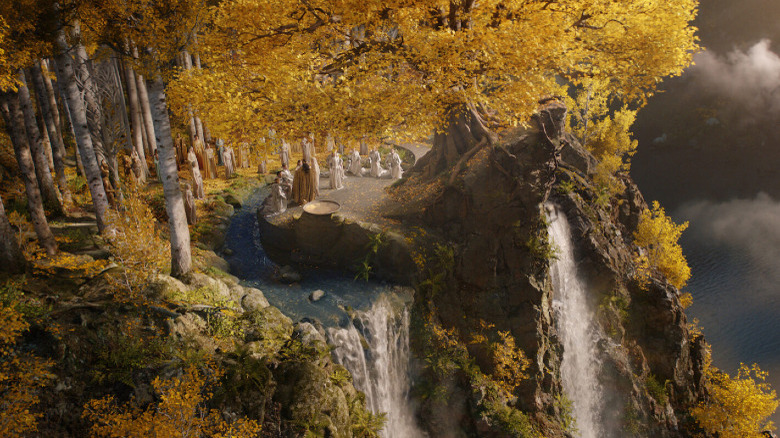What's The Biggest Difference Between The Lord Of The Rings: The Rings Of Power And The Movies?
In 1978, Ralph Bakshi became the first director to bring Middle-earth to the big screen with "The Lord of the Rings," a startling vision that once again reminds us: Animation has always been a medium used for telling stories with great depth and maturity. Running just over two hours and blending elements of J.R.R. Tolkien's first two "Rings" novels, Bakshi used the then-novel technique of rotoscoping to shoot the movie in live-action then trace the footage onto animation cels. Nearly a quarter of a century later, Peter Jackson would adapt Tolkien's fantasy tome into a trilogy of live-action films utilizing cutting-edge CGI and motion-capture effects to realize the story's fantastical setting. In that sense, technical innovation and Tolkien have always gone hand-in-hand.
By that same count, "The Lord of the Rings: The Rings of Power" show-runners J. D. Payne and Patrick McKay have a high bar to clear. Yet, the series has an advantage. Where Bakshi and Jackson had to conjure up a Middle-earth that could somehow live up to and perhaps exceed the one imagined by Tolkien's readers, Payne and McKay are telling a story set long before Frodo Baggins made his legendary trek to Mount Doom. That also means their series takes place in a version of Middle-earth far removed from the one so many people know, in one form or another.
Speaking at the show's panel at the 2022 Comic-Con International in San Diego, Payne pointed to the setting as the biggest difference between "The Rings of Power" and the "Lord of the Rings" films by Jackson. This never-before-seen iteration of Middle-earth led to the series' crew building as many practical sets as possible and driving its production budget to sky-scraping heights, all in the hopes of matching the technical achievements of the Tolkien adaptations before it.
'It's a whole different Middle-earth'
"The Lord of the Rings: The Rings of Power" picks up in Middle-earth's Second Age, a time before the Dark Lord Sauron forged the Rings of Power and plunged the realm into war. It's an era of peace and prosperity, back when the alliance between Men and Elves was going strong, and the kingdoms of Men had not yet fallen into ruin. It's a far cry from the almost post-apocalyptic Third Age of Ralph Bakshi and Peter Jackson's Tolkien adaptations, both aesthetically and in terms of their social structure.
As J.D. Payne pointed out, however, that shouldn't come as any great surprise. When you think of it in terms of how our own world has changed over thousands of years, it only stands to reason that setting of "The Rings of Power" would be very different from Jackson's Middle-earth:
"Well, the show takes place more than 4,000 years before the [Jackson] films do. If you could ask what the changes [are that] you would see, for instance, if this was set in [the] modern-day [world] versus ancient Greece ... It's a whole different Middle-earth."
The footage released from "The Rings of Power" has so far supported this idea, offering snapshots of a Middle-earth where the underground dwarven cities are thriving metropolises, not glorified tombs; where the proto-hobbits, known as harfoots, feel comfortable enough to live as nomads in the wilderness, rather than settling into the secluded safety of the Shire. At the same time, it's plain to see how this world will one day evolve into the one of Jackson's movies, much like you can see the influence of Bakshi's film on Jackson's trilogy.
We'll see if that holds true for the actual show when "The Rings of Power" premieres September 2, 2022 on Prime Video.

